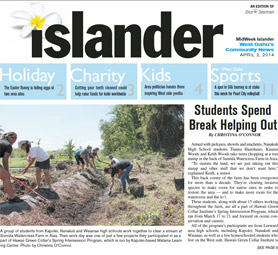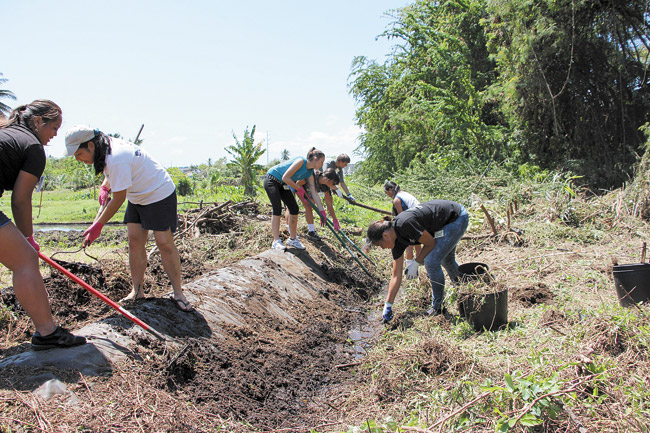Students Spend Break Helping Out
Armed with pickaxes, shovels and machetes, Nanakuli High School students Tianna Hanohano, Kanani Woods and Keith Woods take turns chopping at a tree stump in the back of Sumida Watercress Farm in Aiea.
“To sustain the land, we are just taking out this stump and other stuff that we don’t want here,” explained Keith, a senior.
wo-040214-intercession-cover
A group of students from Kapolei, Nanakuli and Waianae high schools work together to clear a stream at Sumida Watercress Farm in Aiea. Their work day was one of just a few projects they participated in as a part of Hawaii Green Collar's Spring Intersession Program, which is run by Kapolei-based Malama Learning Center. Photo by Christina O'Connor.
This back corner of the farm has been overgrown for more than a decade. They’re clearing invasive species to make room for native ones in order to restore the area – and to make more room for the watercress and the lo’i.
These students, along with about 15 others working throughout the farm, are all a part of Hawaii Green Collar Institute’s Spring Intersession Program, which ran from March 17 to 21 and focused on ocean conservation and careers.
All of the program’s participants are from Leeward area high schools, including Kapolei, Nanakuli and Waianae, as well as a few homeschooled students who live on the West side. Hawaii Green Collar Institute is run by Kapolei-based Malama Learning Center and has provided a series of educational intersession programs since 2010. Each session – some are geared toward teachers instead of students – focuses on a different theme.
“It is basically to just expose (students) to what is out there … and inspire them to realize that this is something they could strive for in the future,” explained Malama Learning Center executive and program director Pauline Sato. “This is kind of the beginning for them. We are hoping that it leads to many more experiences.”
Many of these students, including Hanohano, Kanani and Keith, are interested in pursuing an environment-related career in the future, and they joined the program as a way to discover what is available. Keith plans to go into agriculture, while Hanohano and Kanani, both sophomores, hope to study sustainability and the environment.
The farm trip was the first outing. Also on the agenda for the week was a trip to the new National Oceanic Atmospheric Administration (NOAA) facility on Ford Island, where the students would have the chance to talk with various professionals. The students also were set to go on a behind-the-scenes tour at Waikiki Aquarium, remove invasive algae from a fishpond in Kaneohe and study the coastal ecosystem at Kalaeloa. During the week, a number of conservationists also were scheduled to visit the students to talk about their work. On the last day, the group would sit in on some college classes at Leeward Community College.
As Sato sees it, a crucial component of introducing students to conservation careers is to get them thinking about what they need to do to get there.
“We really want them to go to college, whether it is here or somewhere else, a community college or a four-year college,” Sato said.
“For some of these students, they have no family history in that yet, so we want to encourage them and show them that it is very doable.”
For the students, a main appeal seemed to simply be the opportunity to serve their community and have a hand in restoring the land.
On the other side of the lo’i, two Kapolei High students, Kelsey Cruz and Alixis Eslava, work together to uproot another invasive tree on the hillside.
“I just like to help out and give back,” Cruz said.
Meanwhile, several students clear a thicket in order to improve water flow into the lo’i.
“I just like taking care of our land,” said Nanakuli High sophomore Jahanna Kahele, who wants to go to college to study agriculture.
As an optional follow-up to the intersession program, the students also proposed individual projects to conduct over the next few months. Some of the projects include launching a seed-exchange program, creating a website on ocean conservation, hosting guest speakers at their schools, volunteering with NOAA and making a documentary on lo’i systems.
As the afternoon heated up, Hanohano, Kanani and Keith made progress on the stump. Its roots are deep, but they’re coming along.
“It is a way for us to get in touch with our environment … and apply ourselves to something bigger by taking care of what we have,” Keith said of the program.
“People think, ‘oh West side boys and girls, all they do is go party and drink.’ But it’s spring break and we stay over here trying to learn,” Hanohano said. “And we are going to get this stump out.”







